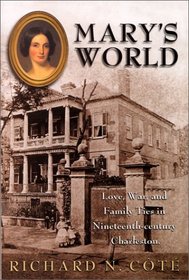Search -
Mary's World : Love, War, and Family Ties in Nineteenth-century Charleston
Mary's World Love War and Family Ties in Nineteenth-century Charleston
Author:
Born to affluence and opportunity in the South's Golden Age, Mary Motte Alston Pringle (1803-1884) represented the epitome of Southern white womanhood. Her husband, William, was a wealthy rice planter who owned four plantations and 337 slaves. Her thirteen children included two Harvard scholars, seven world travelers, three socialite daughters, ... more »
Author:
Born to affluence and opportunity in the South's Golden Age, Mary Motte Alston Pringle (1803-1884) represented the epitome of Southern white womanhood. Her husband, William, was a wealthy rice planter who owned four plantations and 337 slaves. Her thirteen children included two Harvard scholars, seven world travelers, three socialite daughters, ... more »
ISBN-13: 9781929175048
ISBN-10: 1929175043
Publication Date: 11/2000
Pages: 480
Rating: 3
ISBN-10: 1929175043
Publication Date: 11/2000
Pages: 480
Rating: 3
3.8 stars, based on 3 ratings
Publisher: Corinthian Books
Book Type: Paperback
Other Versions: Hardcover, Audio CD
Members Wishing: 0
Reviews: Amazon | Write a Review
Book Type: Paperback
Other Versions: Hardcover, Audio CD
Members Wishing: 0
Reviews: Amazon | Write a Review
Genres:
- Biographies & Memoirs >> General
- Biographies & Memoirs >> Historical >> General
- Biographies & Memoirs >> Historical >> United States >> General
- Biographies & Memoirs >> Historical >> United States >> Civil War >> General
- Biographies & Memoirs >> Leaders & Notable People >> Military >> American Civil War
- Biographies & Memoirs >> Specific Groups >> Women
- History >> Americas >> United States >> Civil War >> General
- History >> Americas >> United States >> Civil War >> Women




